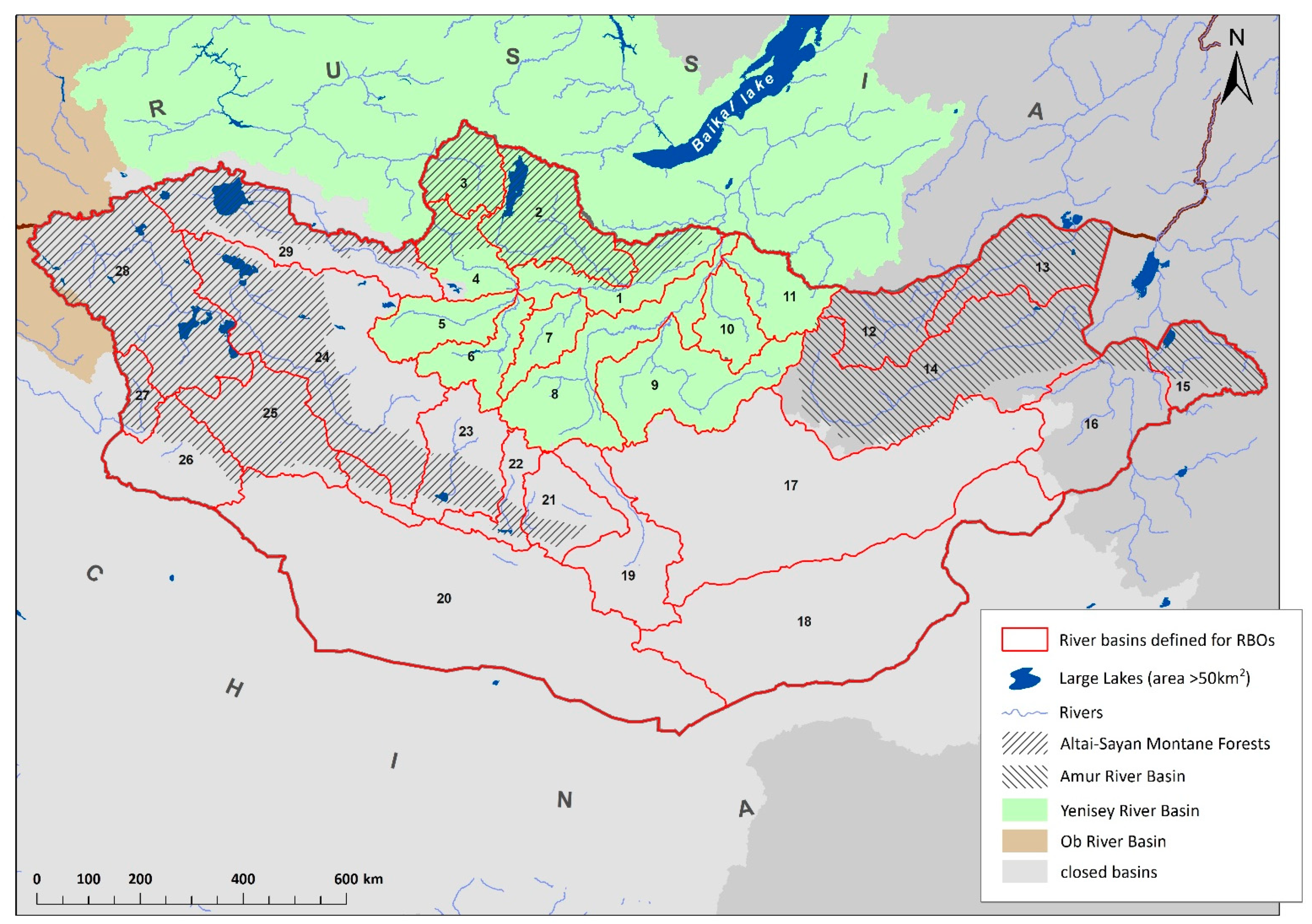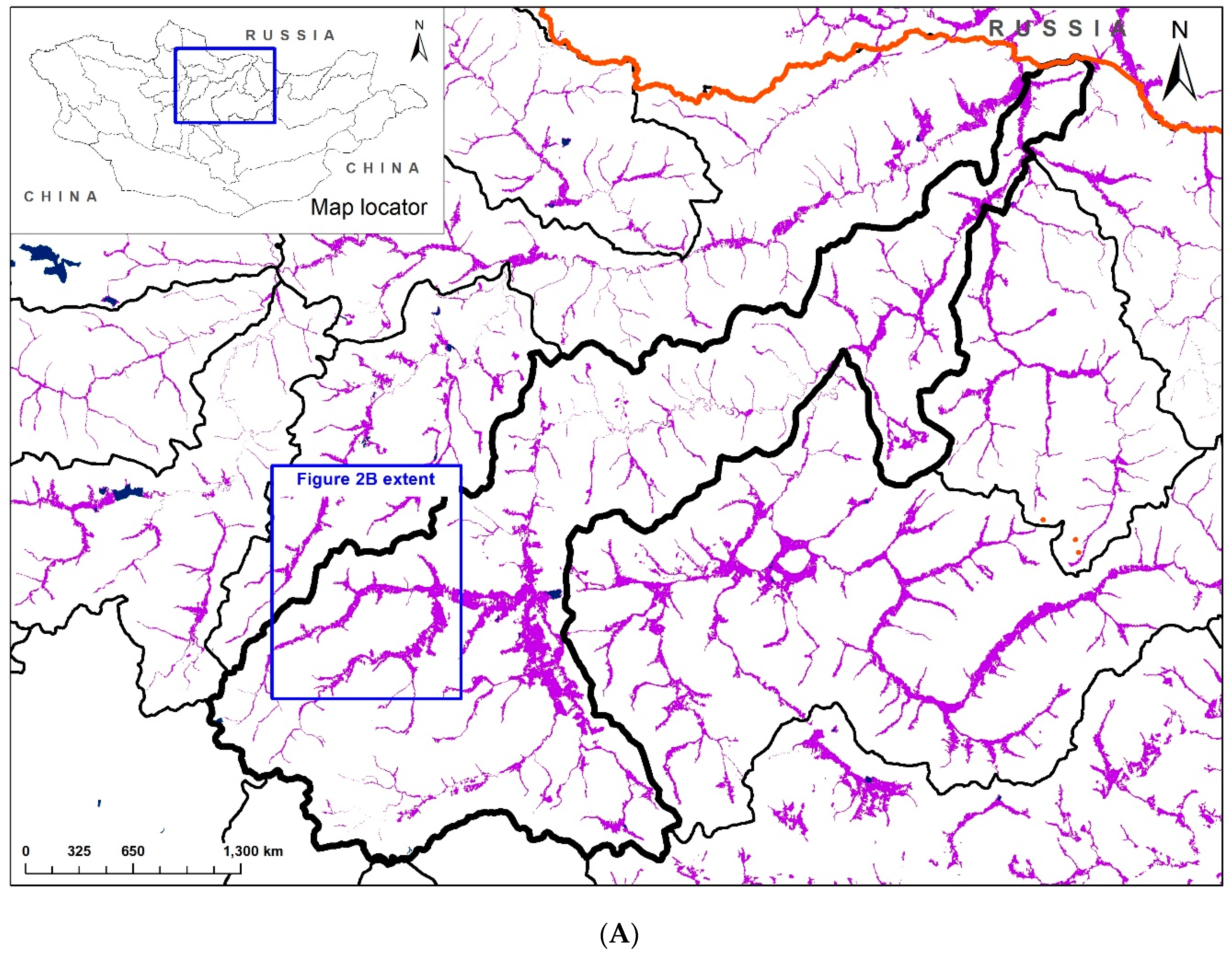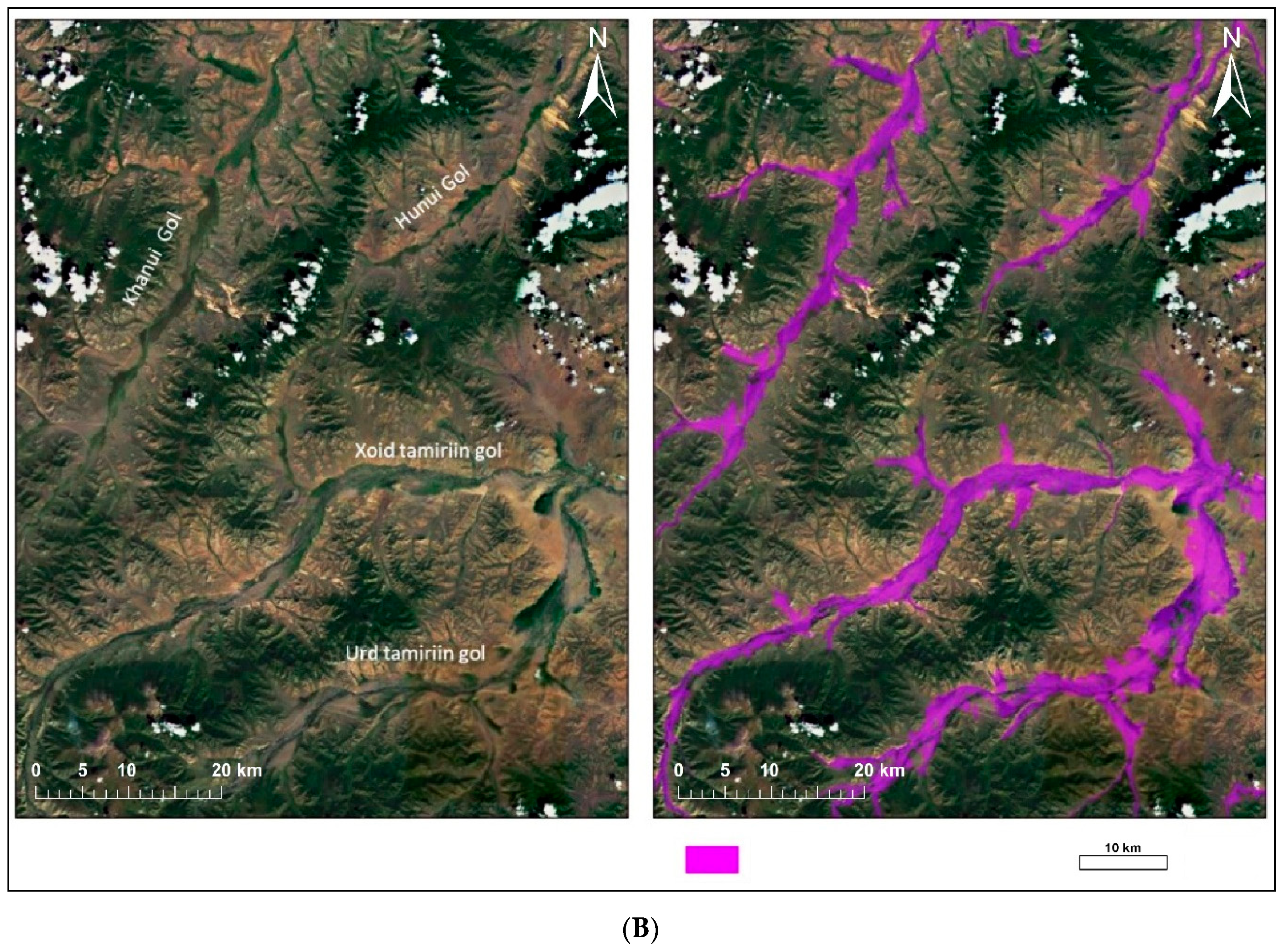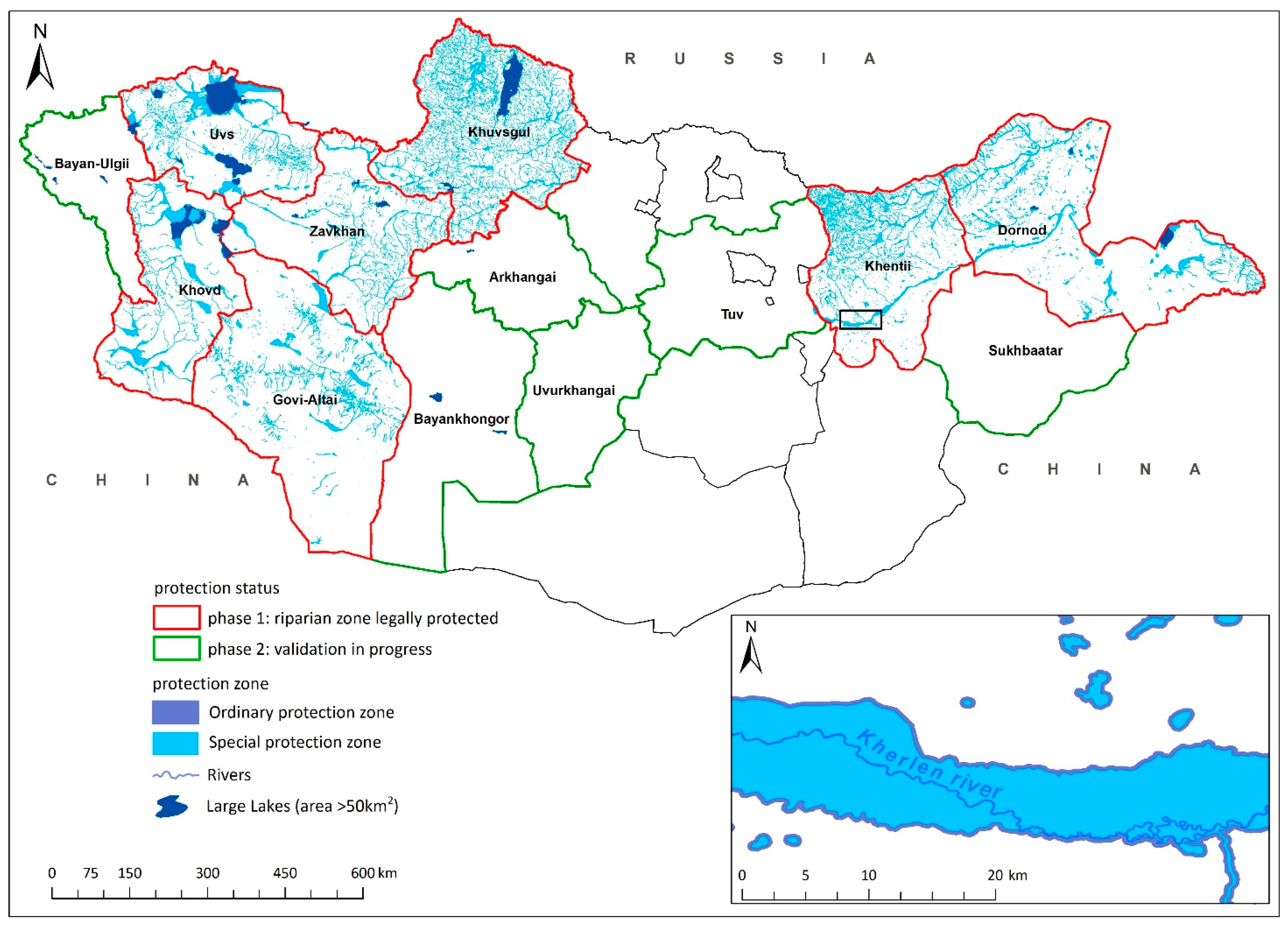Identifying Riparian Areas of Free Flowing Rivers for Legal Protection: Model Region Mongolia
Abstract
1. Introduction
2. Materials and Methods
2.1. Spatial Model
2.2. Review and Validate Jointly with RBAs and AETDs, Approval by Provincial Parliament
3. Results
4. Discussion
4.1. Impacts of Mining to Groundwater Resources
4.2. Stakeholder’s Interest
4.3. Livestock Grazing
4.4. Climate Change
4.5. Landscape Level Mitigation
Author Contributions
Funding
Institutional Review Board Statement
Informed Consent Statement
Data Availability Statement
Acknowledgments
Conflicts of Interest
References
- Tickner, D.; Opperman, J.J.; Abell, R.; Acreman, M.; Arthington, A.H.; Bunn, S.E.; Cooke, S.J.; Dalton, J.; Darwall, W.; Edwards, G.; et al. Bending the curve of global freshwater biodiversity loss: An emergency recovery plan. Bioscience 2020, 70, 330–342. [Google Scholar] [CrossRef] [PubMed]
- Reid, A.J.; Carlson, A.K.; Creed, I.F.; Eliason, E.J.; Gell, P.A.; Johnson, P.T.; Kidd, K.A.; MacCormack, T.J.; Olden, J.D.; Ormerod, S.J.; et al. Emerging threats and persistent conservation challenges for freshwater biodiversity. Biol. Rev. 2019, 94, 849–873. [Google Scholar] [CrossRef] [PubMed]
- Harrison, I.; Abell, R.; Darwall, W.; Thieme, M.L.; Tickner, D.; Timboe, I. The freshwater biodiversity crisis. Science 2018, 362, 1369. [Google Scholar] [PubMed]
- Naiman, R.J.; Decamps, H. The ecology of interfaces: Riparian zones. Annu. Rev. Ecol. Syst. 1997, 28, 621–658. [Google Scholar] [CrossRef]
- Chin, A. Urban Transformation of River Landscapes in a Global Context. Geomorphology 2006, 79, 460–487. [Google Scholar] [CrossRef]
- Davidson, N.C. How much wetland has the world lost? Long-term and recent trends in global wetland area. Mar. Freshw. Res. 2014, 65, 934–941. [Google Scholar] [CrossRef]
- Dixon, M.J.R.; Loh, J.; Davidson, N.C.; Beltrame, C.; Freeman, R.; Walpole, M. Tracking global change in ecosystem area: The Wetland Extent Trends index. Biol. Conserv. 2016, 193, 27–35. [Google Scholar] [CrossRef]
- Almond, R.E.A.; Grooten, M.; Petersen, T. WWF (2020) Living Planet Report—Bending the Curve of Biodiversity Loss; WWF: Gland, Switzerland, 2020. [Google Scholar]
- Reis, V.; Hermoso, V.; Hamilton, S.K.; Bunn, S.E.; Linke, S. Conservation planning for river-wetland mosaics: A flexible spatial approach to integrate floodplain and upstream catchment connectivity. Biol. Conserv. 2019, 236, 356–365. [Google Scholar] [CrossRef]
- Abell, R.; Allan, J.D.; Lehner, B. Unlocking the potential of protected areas for freshwaters. Biol. Conserv. 2007, 134, 48–63. [Google Scholar] [CrossRef]
- Suzuki, Y. Conflict between Mining Development and Nomadism in Mongolia. In The Mongolian Ecosystem Network. Ecological Research Monographs; Yamamura, N., Fujita, N., Maekawa, A., Eds.; Springer: Tokyo, Japan, 2013. [Google Scholar]
- Karthe, D.; Hofmann, J.; Ibisch, R.; Heldt, S.; Westphal, K.; Menzel, L.; Avlyush, S.; Malsy, M. Science-based IWRM implementation in a data-scarce central Asian region: Experiences from a research and development project in the Kharaa River Basin, Mongolia. Water 2015, 7, 3486–3514. [Google Scholar] [CrossRef]
- Simonov, E.A.; Nikitina, O.I.; Egidarev, E.G. Freshwater Ecosystems versus Hydropower Development: Environmental Assessments and Conservation Measures in the Transboundary Amur River Basin. Water 2019, 11, 1570. [Google Scholar] [CrossRef]
- Nikitina, O.I.; Dubinina, V.G.; Bolgov, M.V.; Parilov, M.P.; Parilova, T.A. Environmental Flow Releases for Wetland Biodiversity Conservation in the Amur River Basin. Water 2020, 12, 2812. [Google Scholar] [CrossRef]
- Nyambayar, B.; Tseveenmyadag, N. Directory of Important Bird Areas in Mongolia: Key Sites for Conservation; Wildlife Science and Conservation Center: Ulaanbaatar, Mongolia, 2009; pp. 1–103. [Google Scholar]
- Olson, D.M.; Dinerstein, E. The Global 200: A representation approach to conserving the Earth’s most biologically valuable ecoregions. Conserv. Biol. 1998, 12, 502–515. [Google Scholar] [CrossRef]
- Millenium Ecosystem Assessment. Altai-Sayan Ecoregion Subglobal Assessment Report. In Ecosystems and Human Well-Being-Synthesis: A Report of the Millennium Ecosystem Assessment; Reid, W.V., Mooney, H.A., Cropper, A., Capistrano, D., Carpenter, S.R., Chopra, K., Dasgupta, P., Dietz, T., Duraiappah, A.K., Hassan, R., et al., Eds.; World Wide Fund for Nature Russian Programme: Moskov, Russia, 2005. [Google Scholar]
- Batsaikhan, N.; Buuveibaatar, B.; Chimed, B.; Enkhtuya, O.; Galbrakh, D.; Ganbaatar, O.; Lkhagvasuren, B.; Nandintsetseg, D.; Berger, J.; Calabrese, J.M.; et al. Conserving the world’s finest grassland amidst ambitious national development. Conserv. Biol. 2014, 28, 1736–1739. [Google Scholar] [CrossRef] [PubMed]
- Hoekstra, J.M.; Boucher, T.M.; Ricketts, T.H.; Roberts, C. Confronting a biome crisis: Global disparities of habitat loss and protection. Ecol. Lett. 2005, 8, 23–29. [Google Scholar] [CrossRef]
- Allan, J.; Venter, O.; Watson, J.E.M. Temporally inter-comparable maps of terrestrial wilderness and the Last of the Wild. Sci. Data 2017, 4, 170187. [Google Scholar] [CrossRef] [PubMed]
- Kennedy, C.M.; Oakleaf, J.R.; Theobald, D.M.; Baruch-Mordo, S.; Kiesecker, J. Managing the middle: A shift in conservation priorities based on the global human modification gradient. Glob. Chang. Biol. 2019, 25, 811–826. [Google Scholar] [CrossRef]
- Hijmans, R.J.; Cameron, S.E.; Parra, J.L.; Jones, P.G.; Jarvis, A. Very high resolution interpolated climate surfaces for global land areas. Int. J. Climatol. 2005, 25, 1965–1978. [Google Scholar] [CrossRef]
- Vandandorj, S.; Gantsetseg, B.; Boldgiv, B. Spatial and temporal variability in vegetation cover of Mongolia and its implications. J. Arid Land 2015, 7, 450–461. [Google Scholar] [CrossRef]
- Mongolia 2018 EITI Report: Extractive Industries Transparency Initiative. Available online: https://eiti.org/document/mongolia-2018-eiti-report (accessed on 20 October 2020).
- Stubblefield, A.; Chandra, S.; Eagan, S.; Tuvshinjargal, D.; Davaadorzh, G.; Gilroy, D.; Sampson, J.; Thorne, J.; Allen, B.; Hogan, Z. Impacts of gold mining and land use alterations on the water quality of central Mongolian rivers. Integr. Environ. Assess. Manag. Int. J. 2005, 1, 365–373. [Google Scholar] [CrossRef]
- National Research Council. Riparian Areas: Functions and Strategies for Management; The National Academies Press: Washington, DC, USA, 2002. [Google Scholar]
- Tumurchudur, S.; Jadambaa, D. Integrated Natural Resource Management in the Baikal Basin Transboundary Ecosystem; UNDP-GEF Project: Ulaanbaatar, Mongolia, 2012; pp. 1–35. [Google Scholar]
- Yadamsuren, O.; Morse, J.C.; Hayford, B.; Gelhaus, J.K.; Adler, P.H. Macroinvertebrate community responses to land use: A trait-based approach for freshwater biomonitoring in Mongolia. Hydrobiologia 2020, 1–16. [Google Scholar] [CrossRef]
- Houdret, A.; Dombrowsky, I.; Horlemann, L. The institutionalization of River Basin Management as politics of scale–Insights from Mongolia. J. Hydrol. 2014, 519, 2392–2404. [Google Scholar] [CrossRef]
- Government of Mongolia. Resolution #174: Designating prohibited boundaries of water protection zone. In Government News; Government of Mongolia: Ulaanbaatar, Mongolia, 2011. [Google Scholar]
- Mongolian Government. Resolution #194. Available online: https://www.legalinfo.mn/law/details/8732 (accessed on 20 October 2020).
- Ministry of Environment and Tourism of Mongolia. Ministry of Construction and Urban Development of Mongolia. Ministerial degrees #A-230/127, ensure the water protection regimes for protection zones. In Compilation of Water Regulation, 1st ed.; Myagmar, S., Ed.; Ministry of Environment and Tourism: Ulaanbaatar, Mongolia, 2020; pp. 468–474. [Google Scholar]
- Government of Mongolia. Resolution #254: Establish River Basin Authority, In Compilation of Water regulation, 1st ed.; Myagmar, S., Ed.; Ministry of Environment and Tourism: Ulaanbaatar, Mongolia, 2020; pp. 277–278.
- Fan, M. Achieving Sustainable Integrated Water Resources Management in Mongolia: The Role of River Basin Organizations. ADB Briefs 2020, 138, 1–6. [Google Scholar]
- Ministry of Environment and Green Development of Mongolia and Professional Inspection Agency of Mongolia. Assessment Report of law enforcement on Prohibiting Mineral Exploration and Mining within Protection Zones of Headwaters for Rivers and Streams and Water and Forest Resources Land; Ministry of Environment and Green Development and Professional Inspection Agency: Ulaanbaatar, Mongolia, 2012; pp. 1–14.
- Ministry of Environment and Tourism of Mongolia. Ministerial Degree #A-38: Establish the Working Group to Develop Methodology for Revision of Protection Zones; Ministry of Environment and Tourism of Mongolia: Ulaanbaatar, Mongolia, 2014.
- Smith, M.P.; Schiff, R.; Olivero, A.; MacBroom, J.G. The Active River Area: A Conservation Framework for Protecting Rivers and Streams; The Nature Conservancy: Boston, MA, USA, 2008. [Google Scholar]
- Olivero, S.A.; Barnett, A.; Anderson, M.G. A Stream Classification for the Appalachian Region; The Nature Conservancy, Eastern Regional Office: Boston, MA, USA, 2015. [Google Scholar]
- Martin, E.H.; Apse, C.D.S. Northeast Aquatic Connectivity: An Assessment of Dams on Northeastern Rivers; The Nature Conservancy, Eastern Freshwater Program: Brunswick, ME, USA, 2011. [Google Scholar]
- Nussey, P.; Noseworthy, J. The Active River Area for the Northern Appalachian–Acadian Region of Canada; Nature Conservancy of Canada, Atlantic Regional Office: Fredericton, NB, Canada, 2020. [Google Scholar]
- Iachetti, P.J.; Floberg, G.; Wilhere, K.; Ciruna, D.; Markovic, J.; Lewis, M.; Heiner, G.; Kittel, R.; Crawford, S.; Farone, S.; et al. North Cascades and Pacific Ranges Ecoregional Assessment; Nature Conservancy of Canada: Victoria, BC, Canada, 2006. [Google Scholar]
- Pryce, B.P.; Iachetti, G.; Wilhere, K.; Ciruna, J.; Floberg, R.; Crawford, R.; Dye, M.; Fairbarns, S.; Farone, S.; Ford, M.; et al. Okanagan Ecoregional Assessment; The Nature Conservancy of Canada: Victoria, BC, Canada, 2006. [Google Scholar]
- Heiner, M.; Batsaikhan, N.; Galbadrakh, D.; Bayarjargal, Y.; Zumberelmaa, D.; Ariungerel, D.; Evans, J.; von Werden, H.; Kiesecker, J. Towards a National Spatial Model to Map Terrestrial Ecosystems in Mongolia: A Pilot Study in the Gobi Desert Region. Proceedings of Building Resilience of Mongolian Rangelands: A Trans-disciplinary Research Conference, Ulaanbaatar, Mongolia, 9–10 June 2015. [Google Scholar]
- Goldstein, J.H.; Tallis, H.; Cole, A.; Schill, S.; Martin, E.; Heiner, M.; Paiz, M.C.; Aldous, A.; Apse, C.; Nickel, B. Spatial planning for a green economy: National-level hydrologic ecosystem services priority areas for Gabon. PLoS ONE 2017, 12, e0179008. [Google Scholar] [CrossRef] [PubMed]
- Heiner, M.; Hinchley, D.; Fitzsimons, J.; Weisenberger, F.; Bergmann, W.; McMahon, T.; Milgin, J.; Nardea, L.; Oakleaf, J.; Parriman, D.; et al. Moving from reactive to proactive development planning to conserve Indigenous community and biodiversity values. Environ. Impact Assess. Rev. 2019, 74, 1–13. [Google Scholar] [CrossRef]
- The Nature Conservancy Mongolia Country Program. Identifying Conservation Priorities in the Face of Future Development: Applying Development by Design in the Grasslands of Mongolia; The Nature Conservancy: Ulaanbaatar, Mongolia, 2011. [Google Scholar]
- The Nature Conservancy Mongolia Country Program. Identifying Conservation Priorities in the Face of Future Development: Applying Development by Design in the Mongolian Gobi Desert; The Nature Conservancy: Ulanbaatar, Mongolia, 2013. [Google Scholar]
- The Nature Conservancy Mongolia Country Program. Identifying Conservation Priorities in the Face of Future Development: Applying Development by Design in Western Mongolia: Mongol Altai Mountains, Great Lakes Depression, and Lakes Valley; The Nature Conservancy: Ulaanbaatar, Mongolia, 2017. [Google Scholar]
- The Nature Conservancy Mongolia Country Program. Identifying Conservation Priorities in the Face of Future Development: Applying Development by Design in the Khangai and Khuvsgul; The Nature Conservancy: Ulaanbaatar, Mongolia, 2017. [Google Scholar]
- Lehner, B.; Verdin, K.; Jarvis, A. New global hydrography derived from space borne elevation data. Eos Trans. Am. Geophys. Union 2008, 89, 93–94. [Google Scholar] [CrossRef]
- Classifications of uNified Land Territory: Boundaries of Water Resources Land. Available online: https://gazar.gov.mn/ (accessed on 15 September 2014).
- Ministry of Environment and Tourism of Mongolia. Report for National Surface Water Inventory; Ministry of Environment and Tourism of Mongolia: Ulaanbaatar, Mongolia, 2011.
- Water Database of Mongolia. Available online: https://eic.mn/water/ (accessed on 4 April 2018).
- Landsat Thematic Mapper (TM). Available online: http://earthexplorer.usgs.gov (accessed on 5 September 2020).
- BingMap. Available online: https://www.bing.com/maps (accessed on 5 August 2017).
- GoogleEarth. Available online: https://earth.google.com/web/ (accessed on 13 August 2017).
- Tao, S.; Fang, J.; Zhao, X.; Zhao, S.; Shen, H.; Hu, H.; Tang, Z.; Wang, Z.; Guo, Q. Rapid loss of lakes on the Mongolian Plateau. Proc. Natl. Acad. Sci. USA 2015, 112, 2281–2286. [Google Scholar] [CrossRef]
- Fernandez-Gimenez, M.E.; Batbuyan, B. Law and Disorder: Local Implementation of Mongolia’s Land Law. Dev. Chang. 2004, 35, 141–166. [Google Scholar] [CrossRef]
- Fernandez-Gimenez, M.E. The Effects of Livestock Privatization on Pastoral Land Use and Land Tenure in Post-Socialist Mongolia. Nomadic Peoples 2001, 5, 49–66. [Google Scholar] [CrossRef]
- National Statistics Office of Mongolia. Mongolian Statistical Yearbook; National Statistics Office of Mongolia: Ulaanbaatar, Mongolia, 2018. [Google Scholar]
- Stumpp, M.; Wesche, K.; Retzer, V.; Miehe, G. Impact of Grazing Livestock and Distance from Water Source on Soil Fertility in Southern Mongolia. Mt. Res. Dev. 2005, 25, 244–251. [Google Scholar] [CrossRef]
- Maasri, A.; Gelhaus, J. The new era of the livestock production in Mongolia: Consequences on streams of the Great Lakes Depression. Sci. Total Environ. 2011, 409, 4841–4846. [Google Scholar] [CrossRef] [PubMed]
- Karthe, D.; Heldt, S.; Houdret, A.; Borchardt, D. IWRM in a country under rapid transition: Lessons learnt from the Kharaa River Basin, Mongolia. Environ. Earth Sci. 2015, 73, 681–695. [Google Scholar] [CrossRef]
- Jamsranjav, C.; Reid, R.S.; Fernández-Giménez, M.E.; Tsevlee, A.; Yadamsuren, B.; Heiner, M. Applying a dryland degradation framework for rangelands: The case of Mongolia. Ecol. Appl. 2018, 28, 622–642. [Google Scholar] [CrossRef] [PubMed]
- Chen, F.; Wang, J.; Jin, L.; Zhang, Q.; Li, J.; Chen, J. Rapid warming in mid-latitude central Asia for the past 100 years. Front. Earth Sci. China 2009, 3, 42. [Google Scholar] [CrossRef]
- Davi, N.K.; D’Arrigo, R.; Jacoby, G.C.; Cook, E.R.; Anchukaitis, K.J.; Nachin, B.; Rao, M.P.; Leland, C. A long-term context (931–2005 CE) for rapid warming over Central Asia. Quat. Sci. Rev. 2015, 121, 89–97. [Google Scholar] [CrossRef]
- Pederson, N.; Hessl, A.E.; Baatarbileg, N.; Anchukaitis, K.J.; Di Cosmo, N. Pluvials, droughts, the Mongol Empire, and modern Mongolia. Proc. Natl. Acad. Sci. USA 2014, 111, 4375–4379. [Google Scholar] [CrossRef]
- Batima, P.; Natsagdorj, L.; Gombluudev, P.; Erdenetsetseg, B. Observed climate change in Mongolia. Assess Imp. Adapt. Clim. Chang. Work Pap. 2005, 12, 1–26. [Google Scholar]
- Angerer, J.; Han, G.; Fujisaki, I.; Havstad, K. Climate change and ecosystems of Asia with emphasis on Inner Mongolia and Mongolia. Rangelands 2008, 30, 46–51. [Google Scholar] [CrossRef]
- Ministry of Environment and Tourism of Mongolia. Mongolia Assessment Report on Climate Change; Ministry of Environment and Tourism of Mongolia: Ulaanbaatar, Mongolia, 2009.
- Fassnacht, S.R.; Sukh, T.; Fernandez-Gimenez, M.; Batbuyan, B.; Venable, N.B.H.; Laituri, M.; Adyabadam, G. Local understanding of hydro-climatic changes in Mongolia. Proceedings of the Cold Region Hydrology in a Changing Climate of the IUGG, Melbourne, Australia, July 2011; IAHS Publ.: Melbourne, Australia, 2011; Volume 346, pp. 120–129. [Google Scholar]
- Clare, S.; Krogman, N.; Foote, L.; Lemphers, N. Where is the avoidance in the implementation of wetland law and policy? Wetl. Ecol. Manag. 2011, 19, 165–182. [Google Scholar] [CrossRef]
- Villarroya, A.; Barros, A.C.; Kiesecker, J. Policy development for environmental licensing and biodiversity offsets in Latin America. PLoS ONE 2014, 9, e107144. [Google Scholar] [CrossRef]
- Phalan, B.; Hayes, G.; Brooks, S.; Marsh, D.; Howard, P.; Costelloe, B.; Vira, B.; Kowalska, A.; Whitaker, S. Avoiding impacts on biodiversity through strengthening the first stage of the mitigation hierarchy. Oryx 2018, 52, 316–324. [Google Scholar] [CrossRef]
- State Great Parliament of Mongolia. Master Plan for Protected Areas; State Great Parliament of Mongolia: Ulaanbaatar, Mongolia, 1998. [Google Scholar]
- State Great Parliament of Mongolia. Green Development Policy; State Great Parliament of Mongolia: Ulaanbaatar, Mongolia, 2014. [Google Scholar]
- Heiner, M.; Galbadrakh, D.; Batsaikhan, N.; Bayarjargal, Y.; Oakleaf, J.; Tsogtsaikhan, B.; Evans, J.; Kiesecker, J. Making space: Putting landscape-level mitigation into practice in Mongolia. Conserv. Sci. Pract. 2019, 1, e110. [Google Scholar] [CrossRef]
- Law on Environmental Impact Assessment. Available online: https://www.legalinfo.mn/law/details/8665 (accessed on 20 October 2020).




| Aimag (Province) | Aimag Area | Approved Legal Water Protection Zone | ||||
|---|---|---|---|---|---|---|
| Riparian Area | Special (Strict) | Ordinary (General) | Total | Percent of Aimag | ||
| a | b | c | d | e | f = c + d + e | f/b |
| Uvs | 7,088,446 | 1,167,151 | 82,521 | 223,375 | 1,473,047 | 21% |
| Khovd | 7,777,221 | 857,610 | 50,779 | 201,532 | 1,109,920 | 14% |
| Zavkhan | 8,333,069 | 363,261 | 67,301 | 218,538 | 649,100 | 8% |
| Khuvsgul | 10,131,218 | 655,000 | 336,950 | 1,059,129 | 2,051,079 | 20% |
| Govi-Altai | 14,337,504 | 338,539 | 75,717 | 229,266 | 643,522 | 4% |
| Dornod | 12,535,089 | 861,531 | 61,459 | 244,215 | 1,167,204 | 9% |
| Khentii | 8,101,806 | 541,876 | 279,469 | 368,422 | 1,189,767 | 15% |
| Total | 68,304,353 | 4,784,968 | 954,195 | 2,544,477 | 8,283,640 | 12% |
Publisher’s Note: MDPI stays neutral with regard to jurisdictional claims in published maps and institutional affiliations. |
© 2021 by the authors. Licensee MDPI, Basel, Switzerland. This article is an open access article distributed under the terms and conditions of the Creative Commons Attribution (CC BY) license (http://creativecommons.org/licenses/by/4.0/).
Share and Cite
Surenkhorloo, P.; Buyanaa, C.; Dolgorjav, S.; Bazarsad, C.-O.; Zamba, B.; Bayarsaikhan, S.; Heiner, M. Identifying Riparian Areas of Free Flowing Rivers for Legal Protection: Model Region Mongolia. Sustainability 2021, 13, 551. https://doi.org/10.3390/su13020551
Surenkhorloo P, Buyanaa C, Dolgorjav S, Bazarsad C-O, Zamba B, Bayarsaikhan S, Heiner M. Identifying Riparian Areas of Free Flowing Rivers for Legal Protection: Model Region Mongolia. Sustainability. 2021; 13(2):551. https://doi.org/10.3390/su13020551
Chicago/Turabian StyleSurenkhorloo, Purevdorj, Chimeddorj Buyanaa, Sanjmyatav Dolgorjav, Chimed-Ochir Bazarsad, Batjargal Zamba, Sainbuyan Bayarsaikhan, and Michael Heiner. 2021. "Identifying Riparian Areas of Free Flowing Rivers for Legal Protection: Model Region Mongolia" Sustainability 13, no. 2: 551. https://doi.org/10.3390/su13020551
APA StyleSurenkhorloo, P., Buyanaa, C., Dolgorjav, S., Bazarsad, C.-O., Zamba, B., Bayarsaikhan, S., & Heiner, M. (2021). Identifying Riparian Areas of Free Flowing Rivers for Legal Protection: Model Region Mongolia. Sustainability, 13(2), 551. https://doi.org/10.3390/su13020551







